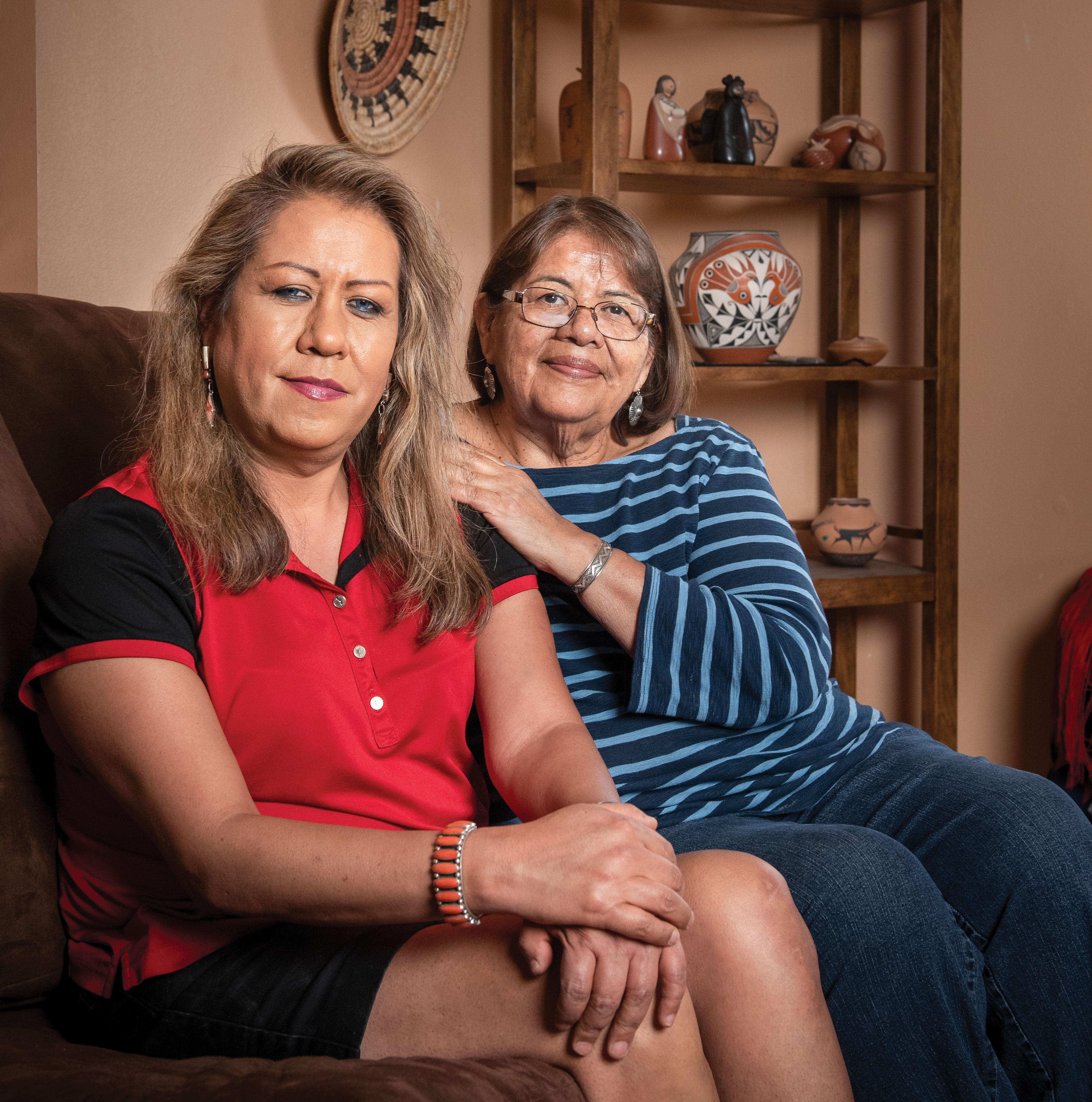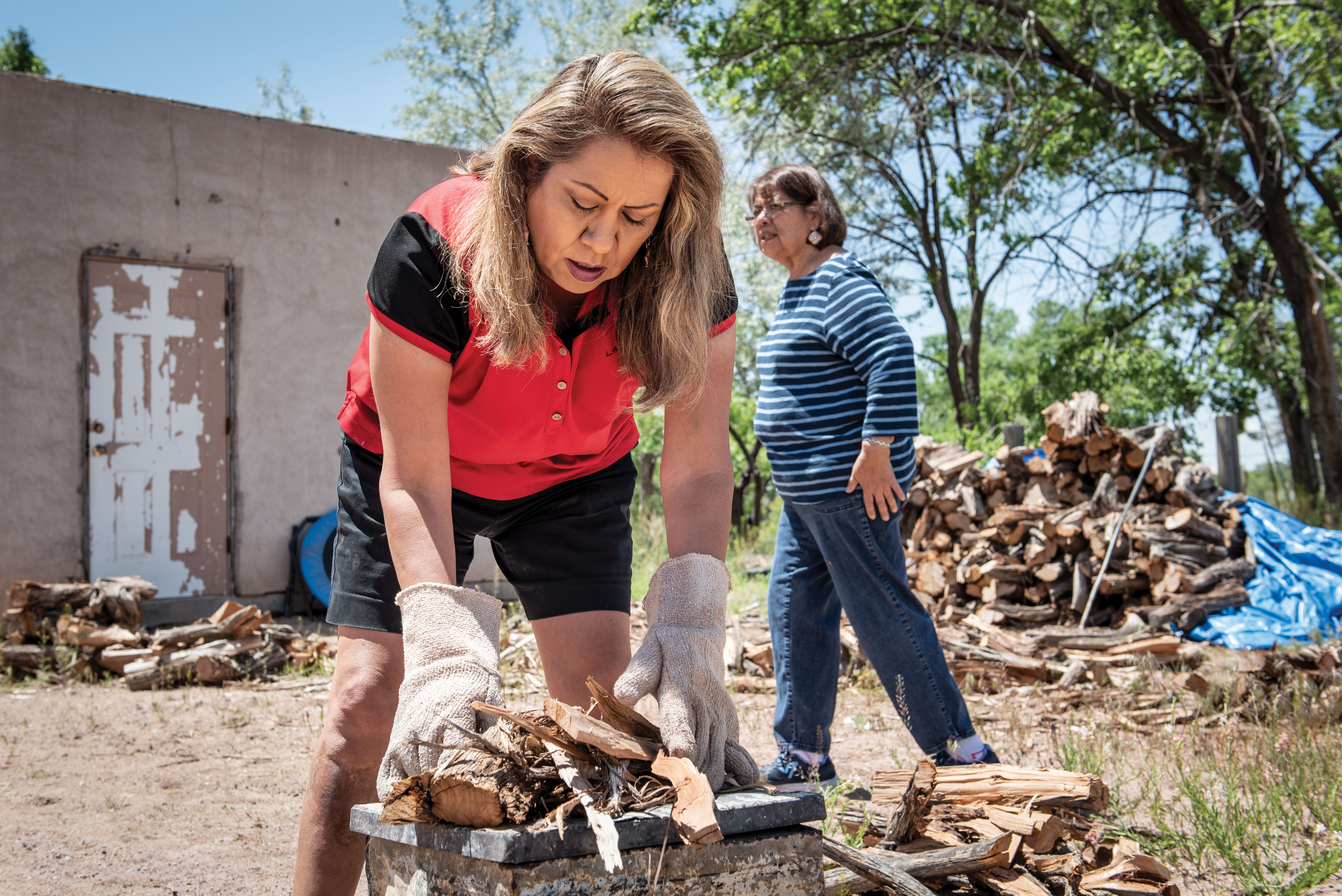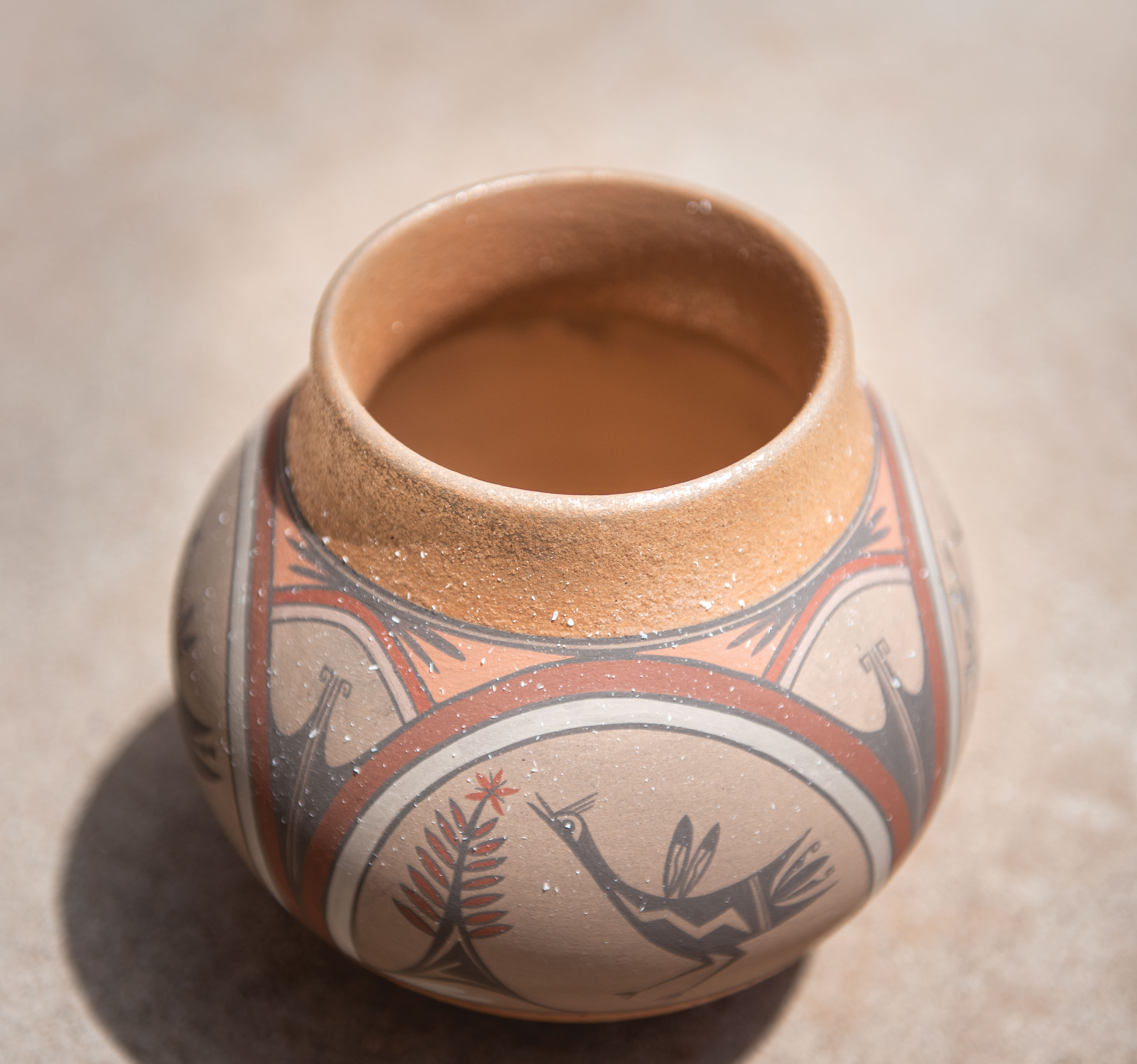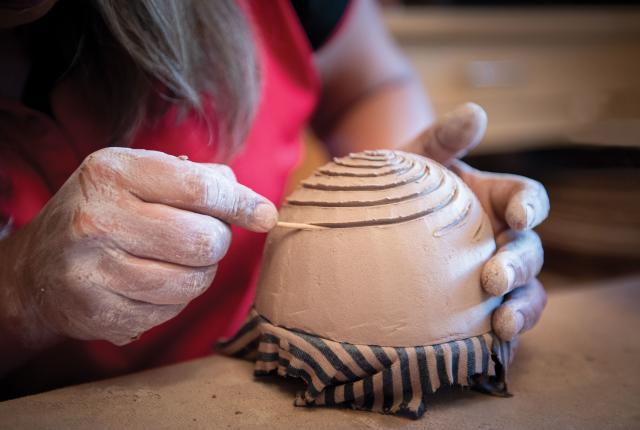Above: Dominique Toya works on a melon swirl pot. Photographs by Stefan Wachs.
DOMINIQUE TOYA TELLS US NOT to be shy, to gather closer so that we can dip our hands in two Ziploc bags filled to the brim with what looks like dirt. Her mother, Maxine Toya, watches as we haphazardly let the particles slip through our fingertips like sand in an hourglass. The first bag, Dominique explains, holds clay, the second, volcanic ash, its tempering agent. Mother and daughter dug each from pits near Jemez Pueblo, where they live, then let both dry out before putting them through sieves to sift out the rocks and roots.
The resulting powder is as fine as flour.
Dominique begins combining the two bags’ contents with water, kneading the mixture on a tabletop covered with canvas sheets, and feeling out the ratios with her hands. As she works it over, her breathing begins to change, becoming more labored with each movement—the sheer physicality of wrestling dirt and water back into wet clay is like awakening it after a long slumber. Maxine hovers nearby, cautioning her daughter not to add too much liquid or “it’ll get too watery.” Dominique responds with a hearty “I know, Mom.”
Welcome to one of their annual workshops, or “comedy hours,” as Dominique calls them—daylong crash courses in their living room that offer a handful of students hands-on experience with clay, from building pots to painting and, finally, firing the finished pottery in a box welded from corrugated roofing tin that sits in the middle of their backyard.
Dominique’s goal in spending these hours schooling the eight of us, she says, is to show that “we’re not just mass-producing pottery, but making it in the traditional way, without a kiln.”
Dominique is gregarious and talkative, ready at any moment to crack a joke, at one point telling us we’ll have to vacuum the floor before leaving, then laughing. She’s been making pottery full-time since age 16, when she dropped out of high school and got a GED because she knew she was book-smart. Marie G. Romero, Dominique’s grandmother, initially taught her how to make pottery. Dominique has since found her own voice as a potter, earning local and national acclaim for her contemporary water jars and seed pots, many adorned with shimmery micaceous clay slips, ribbons of delicately carved swirls, or the sheen of a stone-polished surface.
 Above: Dominique (left) and Maxine Toya in their Jemez Pueblo home.
Above: Dominique (left) and Maxine Toya in their Jemez Pueblo home.
Her mother, whom she calls Max, “because how else can she hear me in a crowd,” is a bit more subdued, a teacher at heart. She deliberately explains everything in detail with the patience of an educator who taught 10-year-olds. Now retired, Maxine logged 35 years at Jemez Day School, and today, it seems, we are her substitute students. When she was still working, Maxine spent her summers molding and painting small abstract figures—angels, corn maidens, and nativity scenes—forms inspired by her time as a student at the Institute of American Indian Arts four decades ago, when internationally lauded sculptor Allan Houser was a faculty member. Now Maxine gets to make pottery whenever she wants.
Dominique doesn’t like to paint, and Maxine isn’t great at making pots, but they complement each other, playing to their strengths and enabling collaborations. Their award-winning work is posted throughout the room—roosted atop the entertainment center, among family photos, and beside glamour shots of Dominique. A cornstalk can be glimpsed on much of it, a stylized and graceful plant that signifies their matrilineal line—the Corn clan that goes all the way back to Dominique’s great-great-grandmother Benina Medina, who was originally from Zia Pueblo. Maxine’s flat-style paintings rendered in the 1980s also line the walls, bringing a toned-down pop-art color palette to an otherwise muted living room.
Their first collaboration had five painted vignettes, one for each generation of women potters, including Benina, her daughter Persingula, and Persingula’s daughter Marie. Then Maxine, then Dominique.
AS THE CLAY STARTS coming back to life with water, Dominique at first finds it an ornery being that resists any certain form—one that needs to be further tempered by hand. Lumps of half-mixed clay fly off the table as she continues kneading, until a large, smooth ball is formed, from which she pulls off chunks to distribute among us. She then makes a request of her mom in Towa, who responds promptly by cracking one of the windows to let some air inside. It’s a brisk morning, but the full-body workout calls for it.
“Sometimes we’ll start speaking in our language during these demonstrations,” Dominique tells us while taking a breath, but “we could just as easily be talking about our nails.” Throughout the day, the two slip easily between English and Towa, a dialect spoken only in Jemez Pueblo.
Dominique finishes kneading, then wipes her arm across her face, declaring that this isn’t something she usually does wearing knee-high stiletto boots. “Just today,” she says playfully, “for you guys,” flashing a wide, lipsticked grin and recalling the one time when she fired pottery outside wearing heels because someone dared her.
Read more: Native potters tell their stories of earth, fire, and remarkable vision.
The clay, though, she and her mother agree, “is alive.” It wants what it wants and will often frustrate the potter’s expectations. In order to work with it, “you have to have a clear, open, and happy mind,” Maxine says. “Sometimes it won’t happen. But sometimes, when I’m in the right place, and it’s the right moment, it does.” “There have been times when I have to make a commission and the clay has another plan for me,” Dominique adds. The two are close. They tend to pick on each other playfully. Sometimes I think it’s just to get a response, maybe laughter or a side-eye. Their strong personalities can clash, too, like when Dominique wants to watch TV while working and Maxine instead turns on the radio to listen to the classical music station. “My daughter,” Maxine says a few days later as she sits at the kitchen table with a half-formed clay figurine in her hand, “is my biggest critic.” “I push her to try new things,” Dominique quips.
Seventeen years ago, Dominique ran for empress of the United Court of the Sandias, a local pageant that traditionally comprises members of the LGBTQ community. Then, as now, Maxine was by her side, but that time it was in the role of campaign manager. Her daughter won by three votes and spent the year traveling to other pageants around the country, Maxine again in tow. “I’m proud of her role in the gay and transgender community,” Maxine says while smiling at Dominique, who is now a promoter for another pageant, the New Mexico All American Goddess. She recently returned from a trip to Daytona Beach, where the national finals were held.
Her daughter’s journey as a transgender woman has become hers, too. Among Dominique’s circle of friends, Maxine has become known affectionately as Mama Toya, the mom who cheered everyone on at the local drag shows before other parents could make the step. “I just want to protect and support her,” she says.
A couple of years back, the emcee at the Social Club, a gay bar in Albuquerque known for its campy drag shows, told Dominique, who regularly performs, to sit down. As a birthday present for her daughter, it was Maxine who sang and performed that night.
“I’m thankful to the universe,” Maxine says, “that Dominique has taken her gift and shared it with the world.”
That gift has to do with more than pottery. Dominique serves on the board of the Southwestern Association for Indian Arts and sells her wares at its annual Indian Market, in Santa Fe, as well as at the Heard Museum Guild’s Indian Fair & Market, in Phoenix. But she often gives away work to support fundraisers with the United Court of the Sandias, which raises money for organizations like N’M Power, Light in the Night, First Nations Community Healthsource, and Southwest Care Center. Dominique also donates her pots to SWAIA’s auction.
 Above: Dominique Toya takes charge of prepping the cedar fire.
Above: Dominique Toya takes charge of prepping the cedar fire.
MAXINE PASSES OUT HUNKS OF CLAY to the rest of us. “The way our grandmother taught us about consistency,” she says, “is that if you make a coil and it breaks, then it’s ready.” We’re seven women and one man, Albert, who’s sitting next to his own mother, Yolanda. Both are visiting all the way from Ysleta del Sur Pueblo, near El Paso, and are already talented potters who enjoy driving north to take weekend workshops together, including this one, their second trip to the Toyas’ home.
I look to my right, and my mom is here, too, trying to make her pot perfect even as it leans. In the end, she makes a pumpkin, while telling all the frustrated people at our shared foldout table that we “need to become children” so that we can be creative again. I smile, because she’s right and because we’re fussing with the clay when it doesn’t seem to want to be fussed with. But who knows. The clay wants what it wants.
In the time it takes for me to make a miniature seed pot the size of a hazelnut, Dominique has produced the body of one of her signature swirl vessels. After coiling and shaping it, she delicately spins the form on its axis to create eight lines with a toothpick that cascade clockwise. Once sanded and fired, it will look as if the ribbon of a sand dune has wrapped itself around the pot. A landscape in miniature.
Then Maxine demonstrates painting, at first licking the purple craft-store brush to sharpen its point and dunking it in a sienna-hued slip. Her pinkie steadies her brush on the surface as she makes fluid lines as deftly as a Japanese calligrapher. Ten movements at most. The result: another simple and beautiful cornstalk.
Our pottery needs at least a week to completely dry out, so on another day I return to watch them fire one of their own creations—a Zia storage jar Dominique built, adding bands of micaceous clay slip to its top and bottom. Within those bands are four arched vignettes where Maxine has painted a delicate bird associated with Zia Pueblo.
As Dominique prepares for the firing, she marshals her years of trial and error to perfect the wielding of heat into an art form of its own. She checks the weather on her phone. Outside, she identifies any excess moisture in the air and on the ground with the precision of a meteorologist. The goal is to keep the pottery intact in this last stage of creation. Humidity can make pots pop under the heat, sending explosions of shards that fly in unpredictable directions within the small box. But even as they cede control to the elements, they always sprinkle cornmeal in advance, praying for a successful firing.
The cedar wood is ready and stacked in the backyard, the only wood they’ll use, because it tends to burn the hottest. They even mail it to workshops as far away as Boston, where they teach high school students at the prestigious Phillips Academy every year. Maxine hands Dominique individual cuts, which she places around the metal box like a pyre. Handfuls of wadded newspaper go in the crevices. And then comes the lighter fluid, which she uses to douse the whole thing. A couple clicks of the lighter and the flames begin to lick the air, making the red hills in the background turn wavy.
 Above: A Zia-bird storage jar wears the ashes of its firing.
Above: A Zia-bird storage jar wears the ashes of its firing.
Dominique paces back and forth, adjusting the wood with a pitchfork. Without the benefit of a thermometer, she stalks the fire, reading how the flames’ sway will affect the outcome. Maxine watches from the porch.
Then, when the fire has burned down to coals, Dominique rakes the ash to the side. She carefully opens the lid of the off-kilter metal box, its corrugated ripples more or less pounded flat. Here again, a finished pot, one more collaboration between mother and daughter. Once only dirt, the still-hot storage jar is but another example of metamorphosis.

SEE FOR YOURSELF, DO IT YOURSELF
Dominique and Maxine Toya will sell their pottery at Indian Market, August 17-18, at booth 256 PAL-N. You can also find their work at King Gallery and Lyn Fox Pueblo Pottery, both in Santa Fe, and Wright’s Indian Art, in Albuquerque.
The next pottery class taught by the Toyas at their home in Jemez Pueblo will be on September 7. For reservations, call Lyn Fox Pueblo Pottery at 505-577-0835 ($150 per person, lunch and materials included).


